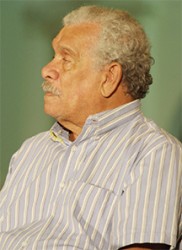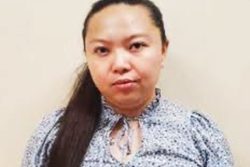The third edition of the Guyana National Drama Festival ended its run of performances last Friday with plays entered by students of the National School of Theatre Arts and Drama. There are many points worthy of note, as was outlined on this page last week. This week we look into further significant features of the Festival and the coincidence of these with developing trends in the contemporary national theatre.
These include the prevalence of new plays and new playwrights; the growing tendency of new plays to want to treat burning social issues; the several new debutante groups turning to theatre as a medium through which to address social concerns and communicate messages; the increased presence of leading professional/commercial theatre companies in the Festival, and the fact that the NDF has played a role in these developments. To these may be added the greater effort by playwrights to extend and tax the imagination in their treatment of those subjects and the effort by directors to do the same and to apply creative techniques in producing the plays.
The Open Full Length Plays Category in the NDF is a significant one. Here is where the leading national dramatists and established senior groups may participate, and it was noted that four plays that have been on the professional or commercial circuit entered the Festival in 2013. This is a slight increase over last year. Three of these just recently completed runs on the local stage while one was brought back after its box office success of many years ago. This shows the NDF moving closer to attracting the reigning professional productions.
 Ronald Hollingsworth’s Watch De Ride II – Justice has been one of the very popular Guyanese plays. It is a sequel to the first Watch de Ride which ranks among the most popular plays, and is a much deeper, better crafted play than its predecessor. That goes against what is most often the case with sequels. It was brought back for public performance earlier in 2013 this time directed by Sheron Cadogan, and was then entered in the Festival.
Ronald Hollingsworth’s Watch De Ride II – Justice has been one of the very popular Guyanese plays. It is a sequel to the first Watch de Ride which ranks among the most popular plays, and is a much deeper, better crafted play than its predecessor. That goes against what is most often the case with sequels. It was brought back for public performance earlier in 2013 this time directed by Sheron Cadogan, and was then entered in the Festival.
Watch De Ride II – Justice uses the ills of the popular minibus sub-culture as a base platform for tackling other issues. Prominent among them are the middle class businessmen whose companies front for their operation of the cocaine trade and the corrupt rogue police officers who are in their pay. It is about organised crime, rape and murder and the corrupting influence of the minibus culture. Yet it counters those with matters about the family, Christianity and the honest officers among the police.
The Berbice Uprising 1763-2013 written and directed by veteran Guyanese dramatist Ras Leon Saul and his company is another major play from the commercial circuit. This was a re-worked version of his play written earlier about the 1763 Berbice rebellion. It is fictionalized historical drama with a good deal of documentary of the events of the uprising. It is not itself an epic drama but it adopts the style and grandeur of epic productions, using the elements of total productions – music, dance, drums and spectacle. The spectacle was quite evident in the set and the costume.

Another of the most popular contemporary Guyanese plays is Anybody See Brenda? by Paloma Mohamed, and it was also entered in this category of the Festival. This play has been one of those most in demand on the local stage and has been brought back many times for re-runs and box office success. It is a situational comedy, very hilarious with a rollicking pace. The Theatre Guild produced it for this year’s NDF with its reflection of topical issues such as the housing situation, the rise of the gay community, including related character studies. It is well set for rousing comic drama.
Derek Walcott’s Pantomime is one of the Caribbean classics in drama. It has also been very popular for its humorous situation, wrought by the interplay between two actors. It is set in Tobago, but has been performed more than once in Guyana in addition to its several runs across the Caribbean and in the USA. Pantomime is a post-colonial take-off on Daniel Defoe’s Robinson Crusoe generously reinforced with satire and picong. Walcott’s technique is to use the pantomime tradition with theatricals and a play-within-a-play. Further techniques include the post-colonial reversal of roles, and from the archetypal master-servant relations between Crusoe and Friday he creates the interplay between a white English hotel owner and his black Trinidadian employee.
Another of the entries that had completed a recent run on the commercial stage was Neaz Subhan’s When Choco-late Melts directed by him for the Indian Arrival Committee, an established company that has mounted several productions over many years. It was yet another entry on the theme of domestic violence. This time it is another new Guyanese play treating societal problems. But this time they are treated with a great deal of humour. Techniques were also essayed, including the use of a maid who functions as a choric voice in the play, with much humour, but after the fashion of the ‘Property Man’ seen in some types of theatre.
The Open Category for Short or One-Act Plays was also significant for the preponderance of attempts at artistic techniques and social commentary. The Professor by Clifford Sealy of Trinidad was something of an exception. It was one of the foreign plays in the festival and yet another humorous one, a comedy of manners with satirical comments on middle class society. Its main craft was the use of language which dictated the rhythms of the performance.
Yet another favourite from years ago was Ken Danns’ The Farepicker directed for the Theatre Guild by Sonia Yarde. Like most of the others it tackles issues plaguing Guyanese society such as the hazards of the single parent family, migration and absent fathers, rape and prostitution. It documents some elements of the industry and was also very noteworthy for its use of imaginative devices by the director. These included the design of the set, the costuming and utilization of music and choreographed movement and action.
All the others in the category were steeped in social commentary and artistic devices. All the rest were new plays, such as A Darker Side written and directed by Tashandra Inniss. Themes reappeared in this one as well, including child abuse, with the possible consequences of this in later life. Religious fanaticism is also treated in a kind of high farce.
Before Her Parting, like so many others, attacked domestic violence, domestic abuse as well as violence against women and girls. In that one too, were suggestions of the results in later life of child abuse. These were handled by several different techniques of imaginative treatment. There were pleas from the after life, the extensive use of lighting and sound devices, as well as specific costuming and the use of the set.
Many of those social ills reappeared in Sonia Yarde’s Mommy directed by Ayanna Waddell. Similarly devastating outcomes arising from child abuse, rape and family dysfunction were dramatised in Mommy. There are themes of hatred and motifs of the cruel stepmother. The application of artistic techniques abound in a very complex play. The production structure was equally complex in the set and its use, the lighting and the sound devices, and very creative.
That play, exhibited the characteristics that dominated the Third National Drama Festival of 2013. It was predominantly theatre of Realism, particularly social realism, but with various bold attempts at creative theatre of Naturalism.








